Title: Generic gap, R vs. D, in Congressional elections of 2012
Post by: pbrower2a on December 06, 2011, 04:08:06 PM
Here's the basic blank map for the electoral vote for President.
(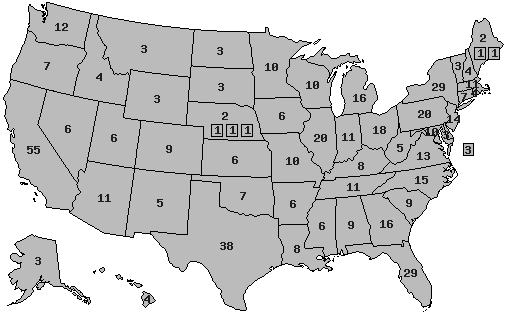 )
)
But -- as a rule, 100 of those electoral votes relate to the US Senate, and 3 to the District of Columbia, which has no Congressional representation. I'm not going to maintain the divide of districts in Maine and Nebraska. So we now have the number of Representatives in each state.
(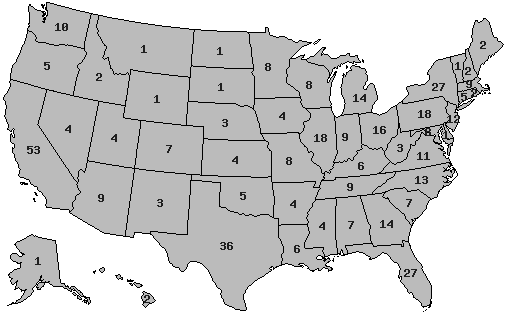 )
)
On the generic ballot:
For a state with at-large representation, use the gap between individual candidates. I'm going with this one for the at large Congressional vote in Montana:
http://www.publicpolicypolling.com/main/2011/06/unknown-republicans-lead-unknown-dems-for-mt-house-seat.html#more
no gap -- white
Democrat (red) or Republican (blue) advantage:
Color to a 20% shade for gaps under 3%, x0% for gaps up to 7%, and 90% for larger gaps.
With a state with multiple Congressional districts (Florida offers a recent example), apply this scheme to the gap in the generic ballot:
(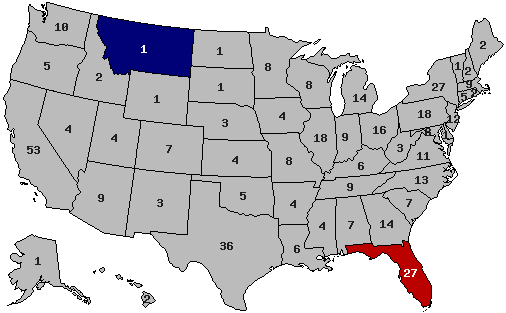 )
)
(
But -- as a rule, 100 of those electoral votes relate to the US Senate, and 3 to the District of Columbia, which has no Congressional representation. I'm not going to maintain the divide of districts in Maine and Nebraska. So we now have the number of Representatives in each state.
(
On the generic ballot:
For a state with at-large representation, use the gap between individual candidates. I'm going with this one for the at large Congressional vote in Montana:
Quote
Q8 If the candidates for House next year were
Republican Steve Daines and Democrat
Franke Wilmer, who would you vote for?
Steve Daines .................................................. 35%
Franke Wilmer ................................................ 25%
Undecided....................................................... 40%
Republican Steve Daines and Democrat
Franke Wilmer, who would you vote for?
Steve Daines .................................................. 35%
Franke Wilmer ................................................ 25%
Undecided....................................................... 40%
http://www.publicpolicypolling.com/main/2011/06/unknown-republicans-lead-unknown-dems-for-mt-house-seat.html#more
no gap -- white
Democrat (red) or Republican (blue) advantage:
Color to a 20% shade for gaps under 3%, x0% for gaps up to 7%, and 90% for larger gaps.
With a state with multiple Congressional districts (Florida offers a recent example), apply this scheme to the gap in the generic ballot:
Quote
Q8 If there was an election for Congress today,
would you vote Democratic or Republican?
Democrat ............... .46%
Republican............. .40%
Not sure ................. .14%
would you vote Democratic or Republican?
Democrat ............... .46%
Republican............. .40%
Not sure ................. .14%
(
Title: Re: Generic gap, R vs. D, in Congressional elections of 2012
Post by: Small Business Owner of Any Repute on December 06, 2011, 04:34:57 PM
oh no.
please no.
dear god, no.
please no.
dear god, no.
Title: Re: Generic gap, R vs. D, in Congressional elections of 2012
Post by: pbrower2a on December 07, 2011, 08:43:20 AM
So what does the gap mean? In Montana it could hardly be more evident: the Democratic challenger is not going to win the at-large House seat up in 2012. In Florida the gap suggests that districts that were less R than R+3 that Republicans now hold are likely to go D with those at R+3 on the bubble.
In essence, the Democrats are not going to win the at-large House seat in Montana, but they stand to make some gains in Florida. The average district is "0" nationwide. Expect a few seats to switch in Florida to the detriment of the Republican majority.
In essence, the Democrats are not going to win the at-large House seat in Montana, but they stand to make some gains in Florida. The average district is "0" nationwide. Expect a few seats to switch in Florida to the detriment of the Republican majority.
Title: Re: Generic gap, R vs. D, in Congressional elections of 2012
Post by: pbrower2a on December 07, 2011, 09:03:23 AM
Pennsylvania, PPP
A state in which Republicans made huge gains in the Congressional delegation is likely to see those reversed in 2012.
http://www.publicpolicypolling.com/pdf/2011/PPP_Release_PA_1129513.pdf
Ohio:
http://www.publicpolicypolling.com/pdf/2011/PPP_Release_OH_1110.pdf
Ohio in 2012 so far looks like an unmitigated disaster for the GOP -- Presidency, Senate, and the House delegation.
On the generic ballot:
For a state with at-large representation, use the gap between individual candidates. I'm going with this one for the at large Congressional vote as I did for Montana:
no gap -- white
Democrat (red) or Republican (blue) advantage:
Color to a 20% shade for gaps under 3%, x0% for gaps up to 7%, and 90% for larger gaps.
With a state with multiple Congressional districts (as in Pennsylvania or Ohio), apply this scheme to the gap in the generic ballot.
(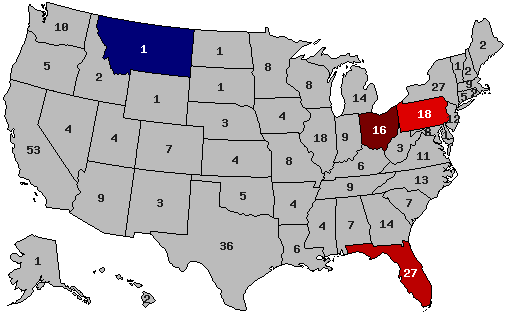 )
)
Quote
Q4 If there was an election for Congress today,
would you vote Democratic or Republican?
Democratic...................................................... 47%
Republican...................................................... 42%
Undecided....................................................... 12%
would you vote Democratic or Republican?
Democratic...................................................... 47%
Republican...................................................... 42%
Undecided....................................................... 12%
A state in which Republicans made huge gains in the Congressional delegation is likely to see those reversed in 2012.
http://www.publicpolicypolling.com/pdf/2011/PPP_Release_PA_1129513.pdf
Ohio:
Quote
Q5 If there was an election for Congress today, do
you think you would vote for the Democratic or
Republican candidate from your district, or are
you not sure?
Democratic candidate ..................................... 49%
Republican candidate ..................................... 39%
Not sure .......................................................... 11%
you think you would vote for the Democratic or
Republican candidate from your district, or are
you not sure?
Democratic candidate ..................................... 49%
Republican candidate ..................................... 39%
Not sure .......................................................... 11%
http://www.publicpolicypolling.com/pdf/2011/PPP_Release_OH_1110.pdf
Ohio in 2012 so far looks like an unmitigated disaster for the GOP -- Presidency, Senate, and the House delegation.
On the generic ballot:
For a state with at-large representation, use the gap between individual candidates. I'm going with this one for the at large Congressional vote as I did for Montana:
no gap -- white
Democrat (red) or Republican (blue) advantage:
Color to a 20% shade for gaps under 3%, x0% for gaps up to 7%, and 90% for larger gaps.
With a state with multiple Congressional districts (as in Pennsylvania or Ohio), apply this scheme to the gap in the generic ballot.
(
Title: Re: Generic gap, R vs. D, in Congressional elections of 2012
Post by: pbrower2a on December 07, 2011, 10:49:04 AM
So what do we have here?
1. The current make-up of Congress is 242-192. That's a 50-seat gap in Congress, one that can be reversed with a 26-seat shift from R to D.
2. Three states with 61 Representatives -- three arguable swing states in 50-50 Presidential elections -- show trouble for Congressional Republicans. Republicans hold a 19-6 majority in the Florida delegation, a 13-5 majority in the Ohio delegation, and a 12-7 majority in the Pennsylvania delegation.
The congressional generic ballot could at worst for the Republicans cause a reversal of the delegations of those states... and that extreme, those three states alone could flip the House in 2012. (26 seats would do it). Republicans will hold ultra-safe seats in all three seats, but I can imagine Democrats winning seats up to R+3 in Florida, R+5 in Ohio, and R+2.5 on average in Pennsylvania.
3. These states are likely to get much attention from President Obama in 2012, and I can easily see him running against Congress -- and exploiting the unpopularity of current Governors. But as significantly, any Republican nominee is going to have few friends who aren't political poison in those states.
4. It's hard to see any cultural trend likely to give the Republicans an advantage in 2012. The Religious Right is fading, and the Tea Party has peaked. The GOP overplayed its hand in 2010 and has left dozens of vulnerable Republicans for 2012.
5. Watch for more states with large Congressional delegations -- Obama states of 2008 (CO, IN, MI, VA, WI), those that he lost by a small margin (GA, MO) with current majority-R or that he won decisively but the delegation is split (MN). Even Texas could be interesting.
1. The current make-up of Congress is 242-192. That's a 50-seat gap in Congress, one that can be reversed with a 26-seat shift from R to D.
2. Three states with 61 Representatives -- three arguable swing states in 50-50 Presidential elections -- show trouble for Congressional Republicans. Republicans hold a 19-6 majority in the Florida delegation, a 13-5 majority in the Ohio delegation, and a 12-7 majority in the Pennsylvania delegation.
The congressional generic ballot could at worst for the Republicans cause a reversal of the delegations of those states... and that extreme, those three states alone could flip the House in 2012. (26 seats would do it). Republicans will hold ultra-safe seats in all three seats, but I can imagine Democrats winning seats up to R+3 in Florida, R+5 in Ohio, and R+2.5 on average in Pennsylvania.
3. These states are likely to get much attention from President Obama in 2012, and I can easily see him running against Congress -- and exploiting the unpopularity of current Governors. But as significantly, any Republican nominee is going to have few friends who aren't political poison in those states.
4. It's hard to see any cultural trend likely to give the Republicans an advantage in 2012. The Religious Right is fading, and the Tea Party has peaked. The GOP overplayed its hand in 2010 and has left dozens of vulnerable Republicans for 2012.
5. Watch for more states with large Congressional delegations -- Obama states of 2008 (CO, IN, MI, VA, WI), those that he lost by a small margin (GA, MO) with current majority-R or that he won decisively but the delegation is split (MN). Even Texas could be interesting.
Title: Re: Generic gap, R vs. D, in Congressional elections of 2012
Post by: Small Business Owner of Any Repute on December 07, 2011, 10:56:35 AM
may the lord have mercy on our souls
Title: Re: Generic gap, R vs. D, in Congressional elections of 2012
Post by: pbrower2a on December 09, 2011, 10:53:45 PM
Quote
Colorado Survey Results
Q1 If there was an election for Congress today,
would you vote Democratic or Republican?
Democratic............. .46%
Republican............. .42%
Not sure ................. .12%
Q1 If there was an election for Congress today,
would you vote Democratic or Republican?
Democratic............. .46%
Republican............. .42%
Not sure ................. .12%
http://www.publicpolicypolling.com/pdf/2011/PPP_Release_CO_12091205.pdf
Republicans will find maintaining a 4-3 majority in the Colorado delegation very difficult, I'd say.
On the generic ballot:
For a state with at-large representation, use the gap between individual candidates. I'm going with this one for the at large Congressional vote as I did for Montana:
no gap -- white
Democrat (red) or Republican (blue) advantage:
Color to a 20% shade for gaps under 3%, x0% for gaps up to 7%, and 90% for larger gaps.
With a state with multiple Congressional districts (as in Pennsylvania or Ohio), apply this scheme to the gap in the generic ballot.
(
Title: Re: Generic gap, R vs. D, in Congressional elections of 2012
Post by: pbrower2a on December 23, 2011, 06:50:27 PM
Republicans cannot hold the House majority nationwide with this:
http://www.publicpolicypolling.com/pdf/2011/PPP_Release_National_1222.pdf
Quote
Q5 If there was an election for Congress today,
would you vote Democratic or Republican?
Democratic...................................................... 46%
Republican...................................................... 44%
Not sure .......................................................... 10%
would you vote Democratic or Republican?
Democratic...................................................... 46%
Republican...................................................... 44%
Not sure .......................................................... 10%
http://www.publicpolicypolling.com/pdf/2011/PPP_Release_National_1222.pdf
Title: Re: Generic gap, R vs. D, in Congressional elections of 2012
Post by: pbrower2a on December 24, 2011, 09:24:41 PM
Not quote a poll of the generic US House ballot in Virginia
http://www.publicpolicypolling.com/pdf/2011/PPP_Release_VA_1222.pdf
but it does suggest that House Republicans will have difficulty holding onto a majority in the Virginia delegation to the US House of Representatives. Like John Boehner and Paul Ryan he looks like a brittle target for nationwide House campaigns.
Merry Christmas!
Quote
Virginia Survey Results
Q1 Do you have a favorable or unfavorable opinion
of Eric Cantor?
Favorable........................................................ 21%
Unfavorable .................................................... 38%
Not sure .......................................................... 41%
Q1 Do you have a favorable or unfavorable opinion
of Eric Cantor?
Favorable........................................................ 21%
Unfavorable .................................................... 38%
Not sure .......................................................... 41%
http://www.publicpolicypolling.com/pdf/2011/PPP_Release_VA_1222.pdf
but it does suggest that House Republicans will have difficulty holding onto a majority in the Virginia delegation to the US House of Representatives. Like John Boehner and Paul Ryan he looks like a brittle target for nationwide House campaigns.
Merry Christmas!
Title: Re: Generic gap, R vs. D, in Congressional elections of 2012
Post by: Southern Senator North Carolina Yankee on December 24, 2011, 10:10:39 PM
It would take a complete sweep of the marginals or somehow regaining VA-09 inspite of Obama in coal country, to flip the delegation.
Wolf, Goodlate, Cantor, Forbes, Whitman and Griffith will be fine. Hurt and Rigell will probably be fine as well.
These generic numbers are not the absolutes you are selling them as. Stop selling us this bill of goods.
Wolf, Goodlate, Cantor, Forbes, Whitman and Griffith will be fine. Hurt and Rigell will probably be fine as well.
These generic numbers are not the absolutes you are selling them as. Stop selling us this bill of goods.
Title: Re: Generic gap, R vs. D, in Congressional elections of 2012
Post by: pbrower2a on January 24, 2012, 07:18:40 PM
It would take a complete sweep of the marginals or somehow regaining VA-09 inspite of Obama in coal country, to flip the delegation.
Wolf, Goodlate, Cantor, Forbes, Whitman and Griffith will be fine. Hurt and Rigell will probably be fine as well.
These generic numbers are not the absolutes you are selling them as. Stop selling us this bill of goods.
Wolf, Goodlate, Cantor, Forbes, Whitman and Griffith will be fine. Hurt and Rigell will probably be fine as well.
These generic numbers are not the absolutes you are selling them as. Stop selling us this bill of goods.
Of course it is possible for a state legislature to gerrymander districts so that three districts are D+20 or more and the rest range from R+10 to R+4 so that only three districts of 12 or so are possible wins for a Democrat except in a Republican disaster.
But two seats flipping in one state, thee in another, and enough others here and there can be the difference between Nancy Pelosi and John Boehner as Speaker of the House.
Individual merit also matters; pols who have sex or corruption scandals, assert themselves as extremists in moderate districts, and misuse power are vulnerable in reverse-wave elections.
Title: Re: Generic gap, R vs. D, in Congressional elections of 2012
Post by: pbrower2a on February 18, 2012, 09:52:07 PM
PPP, Michigan
Imaginable surrogate for how people would vote in Congressional races. Not technically usable here.
On the generic ballot:
For a state with at-large representation, use the gap between individual candidates. I'm going with this one for the at large Congressional vote as I did for Montana:
no gap -- white
Democrat (red) or Republican (blue) advantage:
Color to a 20% shade for gaps under 3%, x0% for gaps up to 7%, and 90% for larger gaps.
With a state with multiple Congressional districts (as in Pennsylvania or Ohio), apply this scheme to the gap in the generic ballot.
(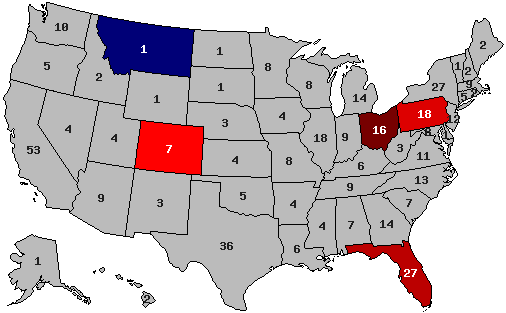 )
)
[/quote]
Quote
Q8 If there was an election for the state legislature
today, would you vote Democratic or
Republican?
Democratic...................................................... 48%
Republican...................................................... 34%
Not sure .......................................................... 19%
today, would you vote Democratic or
Republican?
Democratic...................................................... 48%
Republican...................................................... 34%
Not sure .......................................................... 19%
Imaginable surrogate for how people would vote in Congressional races. Not technically usable here.
On the generic ballot:
For a state with at-large representation, use the gap between individual candidates. I'm going with this one for the at large Congressional vote as I did for Montana:
no gap -- white
Democrat (red) or Republican (blue) advantage:
Color to a 20% shade for gaps under 3%, x0% for gaps up to 7%, and 90% for larger gaps.
With a state with multiple Congressional districts (as in Pennsylvania or Ohio), apply this scheme to the gap in the generic ballot.
(
[/quote]
Title: Re: Generic gap, R vs. D, in Congressional elections of 2012
Post by: pbrower2a on March 09, 2012, 09:30:05 AM
CALIFORNIA
It looks as if many of the Republicans who surfed their way into Congress on the big Republican Wave of 2010 will be wiped out in the big Democratic wave of 2012.
http://www.ppic.org/content/pubs/survey/S_312MBS.pdf
On the generic ballot:
For a state with at-large representation, use the gap between individual candidates. I'm going with this one for the at large Congressional vote as I did for Montana:
no gap -- white
Democrat (red) or Republican (blue) advantage:
Color to a 20% shade for gaps under 3%, x0% for gaps up to 7%, and 90% for larger gaps.
With a state with multiple Congressional districts (as in Pennsylvania or Ohio), apply this scheme to the gap in the generic ballot.
(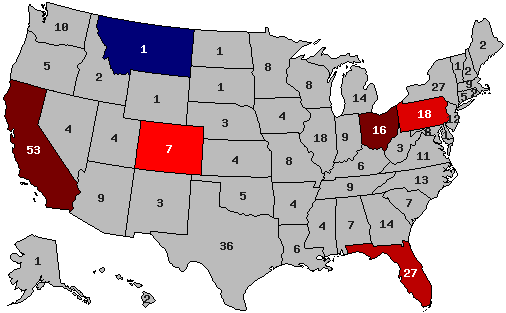 )
)
Quote
When it comes to the outcome of the congressional elections, 50 percent of likely voters prefer a
Congress controlled by Democrats, 35 percent prefer a Republican-controlled Congress, 8 percent are
unsure, and 7 percent volunteer that they prefer neither party to control Congress. A month before
midterm elections in 2006, 55 percent of likely voters preferred Democratic control; in October 2010 they
were divided (45% Democratic control, 43% Republican control). Democrats (79% Democratic control)
and Republicans (77% Republican control) prefer their own parties to control Congress. Over half of
independents favor Democratic control (54%), and one in four prefer Republican control (24%).
Latino likely voters (64%) prefer Democratic control, while white voters are divided (44% Democratic
control, 43% Republican control). Likely voters under age 35 (76%) are far more likely than others (45%
35–54, 44% 55 and older) to prefer Democratic control. Two-thirds of conservatives prefer Republican
control, while 86 percent of liberals and half of moderates (51%) prefer Democrats to control Congress.
Congress controlled by Democrats, 35 percent prefer a Republican-controlled Congress, 8 percent are
unsure, and 7 percent volunteer that they prefer neither party to control Congress. A month before
midterm elections in 2006, 55 percent of likely voters preferred Democratic control; in October 2010 they
were divided (45% Democratic control, 43% Republican control). Democrats (79% Democratic control)
and Republicans (77% Republican control) prefer their own parties to control Congress. Over half of
independents favor Democratic control (54%), and one in four prefer Republican control (24%).
Latino likely voters (64%) prefer Democratic control, while white voters are divided (44% Democratic
control, 43% Republican control). Likely voters under age 35 (76%) are far more likely than others (45%
35–54, 44% 55 and older) to prefer Democratic control. Two-thirds of conservatives prefer Republican
control, while 86 percent of liberals and half of moderates (51%) prefer Democrats to control Congress.
It looks as if many of the Republicans who surfed their way into Congress on the big Republican Wave of 2010 will be wiped out in the big Democratic wave of 2012.
http://www.ppic.org/content/pubs/survey/S_312MBS.pdf
On the generic ballot:
For a state with at-large representation, use the gap between individual candidates. I'm going with this one for the at large Congressional vote as I did for Montana:
no gap -- white
Democrat (red) or Republican (blue) advantage:
Color to a 20% shade for gaps under 3%, x0% for gaps up to 7%, and 90% for larger gaps.
With a state with multiple Congressional districts (as in Pennsylvania or Ohio), apply this scheme to the gap in the generic ballot.
(
Title: Re: Generic gap, R vs. D, in Congressional elections of 2012
Post by: pbrower2a on March 11, 2012, 11:13:54 PM
Here's one that I missed: at-large, South Dakota
http://www.publicpolicypolling.com/pdf/PPP_Release_SD_02021118.pdf
On the generic ballot:
For a state with at-large representation, use the gap between individual candidates. I'm going with this one for the at large Congressional vote as I did for Montana:
no gap -- white
Democrat (red) or Republican (blue) advantage:
Color to a 20% shade for gaps under 3%, x0% for gaps up to 7%, and 90% for larger gaps.
With a state with multiple Congressional districts (as in Pennsylvania or Ohio), apply this scheme to the gap in the generic ballot.
(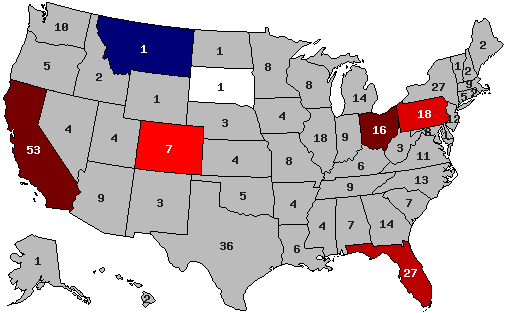 )
)
Quote
If the candidates for Congress next year were Republican Kristi Noem and Democrat Stephanie Herseth Sandlin, who would you vote for?
Stephanie Herseth Sandlin ............................. 46%
Kristi Noem ..................................................... 45%
Stephanie Herseth Sandlin ............................. 46%
Kristi Noem ..................................................... 45%
http://www.publicpolicypolling.com/pdf/PPP_Release_SD_02021118.pdf
On the generic ballot:
For a state with at-large representation, use the gap between individual candidates. I'm going with this one for the at large Congressional vote as I did for Montana:
no gap -- white
Democrat (red) or Republican (blue) advantage:
Color to a 20% shade for gaps under 3%, x0% for gaps up to 7%, and 90% for larger gaps.
With a state with multiple Congressional districts (as in Pennsylvania or Ohio), apply this scheme to the gap in the generic ballot.
(